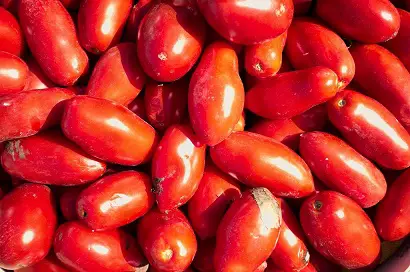Tomatoes come in endless variations and are popular additions to numerous dishes such as salads, soups, stews, and even sauces. One popular variety is the San Marzano, but does this variety need to be peeled before it’s eaten?

Like most tomatoes, San Marzano tomatoes do not need to be peeled before they are eaten. However, if you want to freeze the tomatoes, it’s best to remove both the seeds and the skin before you do so. The skins are much harder to digest and don’t cook down like the flesh, resulting in lumpy sauces.
This article will discuss whether or not San Marzano tomatoes need to be peeled. So keep reading. We have everything you need to know about San Marzano tomatoes.
San Marzano Tomatoes
San Marzano tomatoes take their name from the region that they originate from in Italy. It’s a specific kind of plum tomato that’s typically thinner and longer than the Roma or heirloom tomatoes and is sold fresh and in cans all over the world.
The San Marzano is famed for its balanced flavor that infuses sweet and acid tones to that succulent tomato taste. They were initially grown in a small area between Salerno and Naples in Italy and are a protected food group in Italy.
This particular kind of tomato is often considered the most exquisite of all canned tomatoes and will typically cost you much more per can than other varieties. A large portion of San Marzano tomatoes that are grown are canned and sold around the world. However, only some of these canned goods are from Italy, as the United States now produces its own.
Several people argue that the San Marzanos grown in regions outside of Italy are fakes and do not have the same authentic taste. Even though they are grown in similar conditions, with similar soil, they are not considered DOP San Marzano.
What Does DOP Mean On San Marzano Tomatoes?
You may see that San Marzano tomatoes typically have a DOP at the beginning of their name, but what does this mean? DOP stands for protected designation of Origin and means that the San Marzano tomatoes are only grown in the rich volcanic soil around Mount Vesuvius.
This is the certification for tomatoes that are imported from the Campania region of Italy and ensures that you will be getting the highest quality San Marzano tomatoes.
Do San Marzano Tomatoes Need To Be Peeled?
San Marzano tomatoes are available both as a fresh product, but also in cans that are shipped all over the world. When you receive your fresh San Marzano, you may wonder whether they should be peeled.
This is totally up to one’s preference and usually depends on what you will use the tomatoes for. If they are going on a sandwich or salad, the skin is typically left on. However, if they are going to be used in a sauce or stew, it’s recommended that the skin is removed.
Why Would You Peel A San Marzano?
San Marzano tomatoes from Italy will always come whole and peeled in the can because they are traditionally used to make tomato sauces and stews. This results in a sauce that is smooth and free from any chewy or tough lumps.
So if you plan on making a stew or a sauce from your fresh San Marzano, you should peel them beforehand to ensure that your dish will have a smooth and consistent texture.
If you’re planning on freezing your tomatoes, you may opt to remove the skin of your tomatoes. This will ensure that when the time comes to cook them, they will cook down quickly, and you’ll be left without seeds or strips of skin in your dish, and they will be easy to digest.
How To Peel A San Marzano Tomato
When removing the skin from your San Marzano tomatoes, a few simple tips can make it much easier. The quickest way is to boil your tomatoes in water.
Start by cutting a cross on the bottom of your tomatoes, which will help ensure they peel off easily after they are boiled. Once you have cut a cross into your tomatoes, bring a saucepan of water to boil and insert your tomatoes for around 20 to 30 seconds; then remove one, notice the skin is beginning to peel back.
Once you have boiled the tomatoes, drop them immediately into ice water, and the skins will easily peel off. Once you have completed this step, you can cut the tomatoes in quarters and remove the seeds; thus, you will be left with the perfect tomato for sauces and stews.
Alternative Methods For Peeling A Tomato
If for some reason, you want to peel your tomatoes without boiling them in water, you can use a sharp knife. However, your tomatoes must be very ripe. You’re going to essentially core the tomato by cutting it four times around the stem.
Then take each cut of the tomato and use the sharp edge of the knife to run it along the area above the skin and under the seeds. From here, roll the tomato away from its skin, and it should slowly peel as you move the knife.
Can You Use A Potato Peeler?
If you have thought about using a tomato peeler as an alternative to boiling the tomatoes, this will usually not work. The tomatoes are too soft to use a peeler on, and you’ll be left with a mess. Thus, in this case, you should opt for boiling, as you’ll be left with an easy-to-peel tomato.
Should You Eat San Marzano Tomato Skins?
Now that you know that the reasoning behind the removal of San Marzano tomato skins is that without them, you will be left with fleshy tomatoes that are great for soups and stews, you may be wondering if you can eat the skins.
According to scientists who have studied tomatoes, eating the skins or peels gives your body a good dose of healthy antioxidants, including lycopene, ascorbic acid, flavonoids, and phenolic acids. On top of this, they are full of zinc, calcium, and selenium.
Conclusion
So, now that you know why people remove the skins of San Marzano tomatoes and why they come peeled in cans, you are ready to enjoy these succulent tomatoes in a range of dishes. Just remember that they don’t have to be peeled, and if you’re making a sandwich, why not eat the skins and get an antioxidant boost?
- The Top Restaurants Specializing in Truffle Dishes - August 10, 2023
- Truffle Panna Cotta: A Decadent Dessert Recipe for Truffle Lovers - August 7, 2023
- Truffle Scrambled Eggs: A Luxurious Breakfast Delight - August 7, 2023








